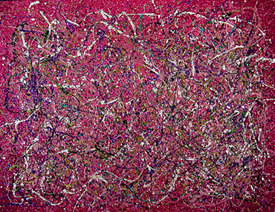Business of Art: Copyright, Fair Use, and the New Borrowers
Nancy Drew. Jackpot (2005). Acrylic, glitter, and flocking on canvas.Courtesy Roebling Hall
Concurrent with the explosion of sophisticated methods of appropriation in visual art, music, and most other artistic genres is a mounting confusion regarding America’s fair use laws for artistic pursuits. Responding to the situation, New York University’s Brennan Center for Justice has recently released a report documenting how and when artists are protected by the country’s fair use laws.
“Usually, all I need is tracing paper and a good light. I can’t understand why I was never an Abstract Expressionist, because with my shaking hand I would have been a natural.”
-Andy Warhol
Add appropriation to the list of artmaking strategies prevalent enough to be considered canonized. Ever since Marcel Duchamp assigned a urinal to be a work of art in 1917, artists have continually challenged concepts of originality and authorship. In the process, they have internalized the use of pre-existing material, weaving it into the fabric of contemporary artmaking. Now a new generation of borrowers like Nate Lowman, Nancy Drew, Eric Doeringer, Paul Pfeiffer, and many others freely take or copy from popular culture (including art history) for a variety of expressive reasons. Appropriation has thus grown from an isolated movement associated with artists like Sherrie Levine and Richard Prince who rose to prominence in the ’80s to a paradigm of artmaking, much like the way conceptual strategies have become so engrained in current art practice. And just as photography has become the new reality in painting, so borrowing is the new creativity in artmaking in general.
Given the resurgence of appropriation-based work, it is timely that New York University’s Brennan Center for Justice recently issued its status report on copyright laws in the current cultural climate. Titled Will Fair Use Survive? Free Expression in the Age of Copyright Control,its conclusions, while grimly stated, actually offer some legal elbow room for contemporary artists (not to mention hip-hop producers and documentary filmmakers) whose work depends on appropriation. In a cut ’n paste, information-based culture where sharing is becoming an ideal (think Wikipedia.org) and intellectual ownership is being questioned, what do copyright laws have to say about the practices of those artists mentioned above?
First, a few brief notes on fair use and copyright law. To quote the Brennan Center report, “Copyright law gives authors, artists, and musicians—or the companies they work for—the ‘exclusive right’ to reproduce, distribute, and perform their works, or to allow others, usually for a fee, to do so. But fair use is an exception to this monopoly control. It allows anyone to copy, publish, or distribute parts—sometimes even all—of a copyrighted work without permission,for purposes such as commentary, news reporting, education, or scholarship.”
Fair use provisions were written to be flexible and open to interpretation on a case-by-case basis, but this also complicates artists’ ability to pin down legally allowable uses (otherwise known as fair use) of existing copyrighted material. According to the Brennan Center report, some large corporations have taken advantage of this vagueness by sending cease and desist or take down letters to individuals they feel are infringing on their copyright. In many cases, artists become intimidated by these letters and the threat of legal action. Many surrender without a challenge, even in cases that a fair use argument would likely win out. It turns out that many artists don’t know the laws and wind up forfeiting the “artistic license” that is at the core of creative activity. To read the full report, visitwww.brennancenter.org.
Recently, many artists have followed the leads of Levine, Prince, and Jeff Koons in challenging fair use and copyright law. At P.S.1’s Greater New York 2005,Nate Lowman presented several blown-up prints of re-photographed magazine images of flaming oil rigs in the middle of the ocean. Then in a recent solo show at Maccarone, Inc. in New York, Lowman exhibited prints of re-photographed magazine covers amongst a rambling installation traversing through the underbelly of American culture, including a “painting” made of bumper stickers and Warhol-like silkscreens of bullet holes.
Nancy Drew, a New York-based artist who shows at Roebling Hall, makes renditions of classic paintings by Abstract Expressionists like Jackson Pollock, Clyfford Still, and Barnett Newman, but personalizes their familiar compositions with glitter, felt, flocking, and slightly altered color schemes.
Eric Doeringer flagrantly rips off designs by well-known artists such as Lisa Yuskavage, John Currin, Takashi Murakami, and Elizabeth Peyton and sells them for cheap on the sidewalks of the Chelsea gallery district. Calling his copies Bootlegs, Doeringer appropriates the business model seen on Canal Street, where vendors sell fake luxury brand handbags and watches just blocks away from SoHo, where the real things sell for much, much more.
Paul Pfeiffer is known for re-editing Hollywood films and sports video and photography, often abstracting the context in which a figure interacts with their given situation. One of his pieces,Fragment of a Crucifixion, is a short video loop of the basketball player Larry Johnson screaming in ecstasy after a made shot. Isolated and repeated, his reaction becomes something like the rage of a trapped animal turned into spectacle.
Fair use protects all of these artists from copyright owners in different ways. Lowman could argue that his work is a critique of the saturation of mass media imagery like the ones he copies. His work owes a lot to Levine and Prince, both of whom controversially shaped the dialogue on authorship in the 1980s by re-photographing existing, well-known photographs.
Because Drew only imitates certain styles without copying specific works, her practice is safe from allegations of copyright infringement. Styles cannot be copyrighted; only specific works can.
In the case of Doeringer, by calling his pieces Bootlegs, he can argue that there is no chance of confusing his copies with the originals. Another factor in determining legal fair use is the effect of the use on the potential market for the copyrighted work. In other words, would Doeringer’s $100 copy of a John Currin painting affect the market for an original Currin painting, which sells for tens of thousands of dollars? One could argue that these are two different markets and that therefore, Doeringer’s use is fair.
Because Pfeiffer appropriates from very well known sources (video of famous boxing matches, sports photography from NBA games, Hollywood films, etc.), his work seems the most in danger when it comes to copyright infringement. However, since Pfeiffer often uses only small fragments of a film or video, his work can be protected by the 1976 Copyright Act fair use stipulation that considers “the amount and substantiality of the portion used in relation to the copyrighted work as a whole.”
The Copyright Act and its fair use doctrine do seem hopelessly behind the times in protecting the creative activity of contemporary artists. Artists these days aren’t borrowing from existing works to profit from them, which the law was trying to protect against. Intrinsic to the strategy of borrowing practiced by the artists mentioned above is, of course, a critique of creativity. But it is also an homage to the original and an attempt to create something new from it. This is, in fact, the model of a distinctly postmodern manifestation: hip-hop music.
One of hip-hop’s greatest lessons is that “flipping” a pre-existing piece of music (sampling and manipulating it creatively) can result in something original and unique which lends new beauty to the old, and in which the old offers a striking context to the new. The popular success of the genre has spurred a blossoming of sampling to the point that it has grown beyond mere quotations of originals into its own art form. In the visual arts, in spite of the art market’s mythologizing of the artist as a one-of-kind author, artists are using the form of appropriation as a tool, a flexible strategy available to artists who now seek to redefine standards of creativity—one where artmaking is a shared, social activity.
—Herb Tam
For more information on copyright and fair use, visit brennancenter.org.
Herb Tam is a NYFA Source Program Officer and an independent curator.





